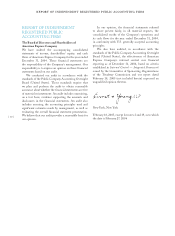American Express 2006 Annual Report Download - page 64
Download and view the complete annual report
Please find page 64 of the 2006 American Express annual report below. You can navigate through the pages in the report by either clicking on the pages listed below, or by using the keyword search tool below to find specific information within the annual report. [ 62 ]
2006 fi nancial review
american express company
Securitization income, net — Net securitization income
includes non-credit provision components of the
net gains and charges from securitization activities;
impairment charges, if any, of the related interest-only
strip; excess spread related to securitized cardmember
loans; net finance charge revenue on retained interests
in securitized cardmember loans, and servicing income,
net of related discounts or fees. Excess spread is the
net positive cash flow from interest and fee collections
allocated to the third-party investors’ interests in the
securitization after deducting the interest paid on the
investor certificates, credit losses, contractual servicing
fees, and other expenses. Excess spread is recognized as
it is earned.
Stored value and prepaid products — Include Travelers
Cheques and other prepaid products such as gift cheques
and cards as well as reloadable Travelers Cheque cards.
These products are sold as safe and convenient alternatives
to currency for purchasing goods and services.
Total cards-in-force — Represents the number of cards
that are issued and outstanding. Total consumer cards-in-
force includes basic cards issued to the primary account
owner and any supplemental cards which represent
additional cards issued on that account. Total small
business and corporate cards-in-force include basic cards
issued to employee cardmembers. Proprietary cards-in-
force represent card products where the Company owns
the cardmember relationship including card issuance,
billing and credit management and strategic plans
such as marketing, promotion, and development of
card products and offerings. Proprietary cards-in-force
include co-brand and affinity cards. For non-proprietary
cards-in-force (except for certain network partnership
agreements), the Company maintains the responsibility
to acquire and service merchants that accept the
Company’s cards and the cardmember relationship is
owned by the Company’s network partners that issue
the cards.
Travel sales — Represents the total dollar amount of
travel transaction volume for airline, hotel, car rental,
and other travel arrangements made for consumers and
corporate clients. The Company earns revenue on these
transactions by charging a transaction or management
fee.
FORWARD-LOOKING STATEMENTS
This report includes forward-looking statements,
which are subject to risks and uncertainties. The words
“believe,” “expect,” “anticipate,” “optimistic,” “intend,”
“plan,” “aim,” “will,” “may,” “should,” “could,” “would,”
“likely,” and similar expressions are intended to identify
forward-looking statements. Readers are cautioned
not to place undue reliance on these forward-looking
statements, which speak only as of the date on which
they are made. The Company undertakes no obligation
to update or revise any forward-looking statements.
Factors that could cause actual results to differ materially
from these forward-looking statements include, but are
not limited to, the following: the Company’s ability to
meet its ROE target range of 33 to 36 percent on average
and over time, which will depend in part on factors such
as the Company’s ability to generate sufficient revenue
growth and achieve sufficient margins, fluctuations
in the capital required to support its businesses, the
mix of the Company’s financings, and fluctuations in
the level of the Company’s shareholders’ equity due to
share repurchases, dividends, changes in accumulated
other comprehensive income and accounting changes,
among other things; the Company’s ability to grow its
business and meet or exceed its return on shareholders’
equity target by reinvesting approximately 35 percent of
annually-generated capital, and returning approximately
65 percent of such capital to shareholders, over time,
which will depend on the Company’s ability to
manage its capital needs and the effect of business mix,
acquisitions and rating agency requirements; consumer
and business spending on the Company’s credit and
charge card products and Travelers Cheques and other
prepaid products and growth in card lending balances,
which depend in part on the ability to issue new and
enhanced card and prepaid products, services and
rewards programs, and increase revenues from such
products, attract new cardmembers, reduce cardmember
attrition, capture a greater share of existing cardmembers’
spending, and sustain premium discount rates on its card
products in light of regulatory and market pressures,
increase merchant coverage, retain cardmembers after
low introductory lending rates have expired, and expand
the Global Network Services business; the success of the
Global Network Services business in partnering with
banks in the United States, which will depend in part on
the extent to which such business further enhances the
























